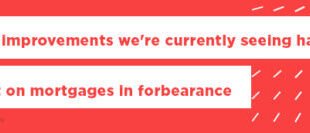
If you want to buy a house but have student loan debt, you may be wondering if it’s possible.
This article will look at how your eligibility for a mortgage loan can be affected by student loan debt and provide tips to help you qualify.
Rate Search: Check Today’s Mortgage Rates
How Student Loans Affect Getting a Mortgage
Student loans affect your debt-to-income (DTI) ratio, which is the amount of your gross monthly income that goes towards your monthly debt obligations such as minimum credit card payments, auto loans, and student loan payments.
Front-end DTI ratio – Your front-end ratio is your debt-to-income before factoring in your estimated monthly mortgage payments.
Back-end DTI ratio – Your back-end ratio is your debt-to-income after factoring in your estimated monthly mortgage payments.
For example, if your gross pre-tax income is $ 5,000 per month and your monthly student loan payments are $ 300, a $ 300 monthly auto loan payment and credit card payments total $ 400 per month. Your total monthly debt payments are $ 1,000. Your front-DTI ratio is 20%.
DTI Ratio Needed for a Mortgage
Mortgage lenders typically require a front-end DTI ratio of 28% and a back-end DTI ratio of 43% to 50% to qualify for a mortgage. The maximum DTI required depends on the type of mortgage you get and your credit rating. Government home loans such as FHA loans and USDA loans allow for higher DTI ratios up to 50%. Conventional loans allow for a maximum 43% DTI ratio.
Maximum DTI Ratio Requirements by Loan Type
- FHA Loans – 50%
- VA Loans – 50%
- USDA Loans – 50%
- Conventional Loans – 43%
- Home Possible / HomeReady Loans – 50%
Improve Your Debt-to-Income Ratio
If you have student loan debt and a high DTI ratio, you should improve it to increase your chances of being approved for a mortgage.
- Refinance your loans – You may be able to refinance your student loans, personal loans, or auto loans to a lower rate and payment.
- Contact your creditors – Your credit card creditors may be willing to work with you to lower your interest rates and monthly payments.
- Increase your income – Maybe it’s time to ask your employer for a raise. You can also get a second job or put your skills to use by doing freelance work on the side. Improving your income isn’t always as difficult as it sounds, and it will increase your DTI ratio.
Defer Your Student Loans
If you have federal student loan debt, you can defer them if you meet the criteria. You may be eligible if you are enrolled in a graduate program, are a veteran, or have financial issues. Check if you meet the requirements to defer your student loans on the Federal Student Aid website.
Improve Your Credit Score
The higher your credit score, the lower your interest rate will be. A higher score also allows lenders to accept a higher DTI ratio. Before you apply for a mortgage, you should work on improving your credit score.
- Pay down your credit card debt – Your credit utilization ratio is the amount of available credit you’re using, and it accounts for 30% of your fico score. Try paying down your balances to less than 25% of your credit limits to maximize your score. You can also contact your creditors to ask them to raise your credit limits.
- Dispute negative accounts – You can dispute anything on your credit report you believe is inaccurate with the credit bureaus. They have 30 days to contact the creditor to validate the account, or it must be removed from your credit report entirely.
- Pay your bills on time – Your payment history is the biggest factor in determining your credit score, making up 35% of your overall fico score. You need to stay on top of your payments; a single late payment can significantly impact your score.
Tips on how to increase your credit score in 30 days
Get Pre-Approved First
Getting pre-approved for a mortgage is the first step in buying a home. It will tell you if your debt-to-income ratio is too high, so you can take the steps outlined in this article to lower your DTI. You can be pre-approved quickly. A lender will need to pull your credit and verify your income and assets. Have the following documents to speed up the process.
- Last two years w2’s and tax returns
- 30 days of pay stubs
- Last two months of bank statements
Get Pre-Approved and Check Today’s Rates
Consider all Loan Types
You will not qualify for a conventional mortgage with a DTI ratio above 43%. Government home loans have less strict DTI requirements allowing borrowers to qualify with up to a 50% DTI ratio.
FHA Loans
FHA loans aren’t just for first-time homebuyers but you could be eligible with a 580 credit score, a 3.5% down payment, and a DTI ratio as high as 50%.
Home Possible / HomeReady Loans
Fannie Mae and Freddie Mac created the Home Possible and HomeReady loan programs for low-income buyers whose income is below 100% of the area median income (AMI). You can qualify with up to a 50% DTI ratio, a 620 credit score, and just 3% down.
First-Time Home Buyer Programs
You may be eligible for first-time homebuyer programs that provide down payment and closing cost assistance. You can also check for local first-time homebuyer programs in your state by going to the HUD website.
The Bottom Line
You can buy a house with student loan debt. Just remember the monthly student loan payments count against your debt-to-income ratio, so you should work on improving it.
Paying down debt, getting a second stream of income, and raising your credit score can help you.
You should also check if you’re eligible to defer your federal student loans.



